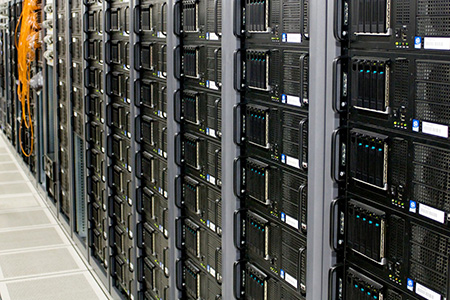Whether your datacenter fills a building the size of a stadium or just a closet at the end of the hallway, getting AC power to all the devices that need it is critical. Servers, switches, routers, gateways, and other hardware all need power to run. The job of delivering that power in a datacenter environment is handled by power distribution units (PDUs), which takes line AC and distributes it to multiple devices.
Small datacenters such as the archetypical “server room” may only have one PDU installed in a rack that powers all the other devices in the rack or cabinet. Things become a bit more hierarchical when it comes to large datacenters, however, where you may have a collection of PDUs centrally managed from a controller unit. Power going into the PDUs can range up to 22 kVA or even higher. And instead of connecting your servers and other devices directly to these PDUs, the power that’s put out from them is routed to remote power panels (RPPs). They then deliver the power to the racks where the servers are installed, either through “whips” (power cabling that runs under a raised floor) or via an overhead series of conduits or tracks.
Before we look at some recommendations on which PDUs might be best for your environment, let’s stop for a moment and examine some of the different kinds of PDUs that are available.

Types of PDUs
The most common type of PDU comes in a horizontal box with a 1U or 2U height. This form factor allows you to install the PDU in a standard 19-inch rack or cabinet the same way you install your servers, storage arrays, and other computing hardware. PDUs can be vertically mounted on an outside edge of your rack, but these are generally less commonly used than the horizontal variety.
Your most basic kind of PDU simply distributes unfiltered AC power drawn in from a wall outlet or a UPS system and provides a series of AC outlets you can use to plug in the power cords of other devices in the rack. Monitored PDUs take things a step further by filtering incoming power and supporting remote monitoring via SNMP. Monitored PDUs may also include switching capabilities to enabling you to control the power to connected devices via SNMP, for example, to perform controlled power cycling or to provide accurate power usage metrics for billing purposes. Most of these PDUs also support some form of local metering, for example, through a digital display on the unit.
From this point on, the features start multiplying like rabbits. PDUs can send you emails or text messages to notify you when a power-related event happens to a connected device, for example when a load threshold you have specified is exceeded. PDUs can support incoming power from two separate AC sources and funnel power to single-corded equipment for purposes of redundancy. PDUs can enable power for devices to be automatically transferred to a UPS as source, so workloads aren’t interrupted should the PDU need to be replaced. PDUs can even respond to changing environmental conditions, for example by ramping up the load to attached fans when the air conditioning fails in a cabinet.
Most useful of all for larger datacenters such as colocation facilities where high server densities are achieved is the ability for PDU vendor-supplied software to automatically configure and remotely manage multiple downstream PDUs from a single central “master” PDU having both metering and remote monitoring capabilities, also called a management controller. This category that goes by a moniker like “Intelligent PDU” is, of course, the most expensive but is an essential investment for today’s modern datacenter, especially those that provide cloud services to customers.
Then there is the good old power strip. What could go wrong with using something as simple as that?
Tripping the fire marshal

When we say that working in IT is a trip, we don’t mean you should trip over a power strip or extension cord in your datacenter. Commodity stuff like that is generally a no-no in datacenters because, by being not permanently attached to racks and enclosures, they usually violate the local fire codes in your district or area. And stacking them together — connecting the power cord of a piece of networking hardware to a power strip which is plugged into a second power strip which plugs into an extension cord which runs into the outlet on the side of your room — will be very much frowned upon by the file marshal when they come to visit your setup for inspection and approval. “That’s against code,” the fire marshal comments, ticking a box on the paper attached to their clipboard. The same can go for connecting power taps and surge protectors to each other or connecting several power distribution units to a cube tap instead of to separate individual outlets. So make sure you know your local fire codes or you might get dinged with a citation the next time the fire marshall visits your facility.
Some power distribution units recommendations

Let me end with a few quick recommendations concerning vendors you may want to consider if you’re looking to purchase some power distribution units. Several of my colleagues recommend APC as a good brand for PDUs for their datacenters. At the high end, there is the 9000 Series Switched Rack PDU family while for server rooms the vertically-mounted AP8858 may be sufficient. Server Tech is also popular with many of my colleagues, they have various product lines that include Smart PDUs and Switched PDUs you may want to check out. And finally, one of my colleagues who manages a datacenter swears by the PX Intelligent Rack PDU Series from Raritan PDU. Feel free to recommend other PDU vendors you have knowledge or experience with.
Featured image: Shutterstock



